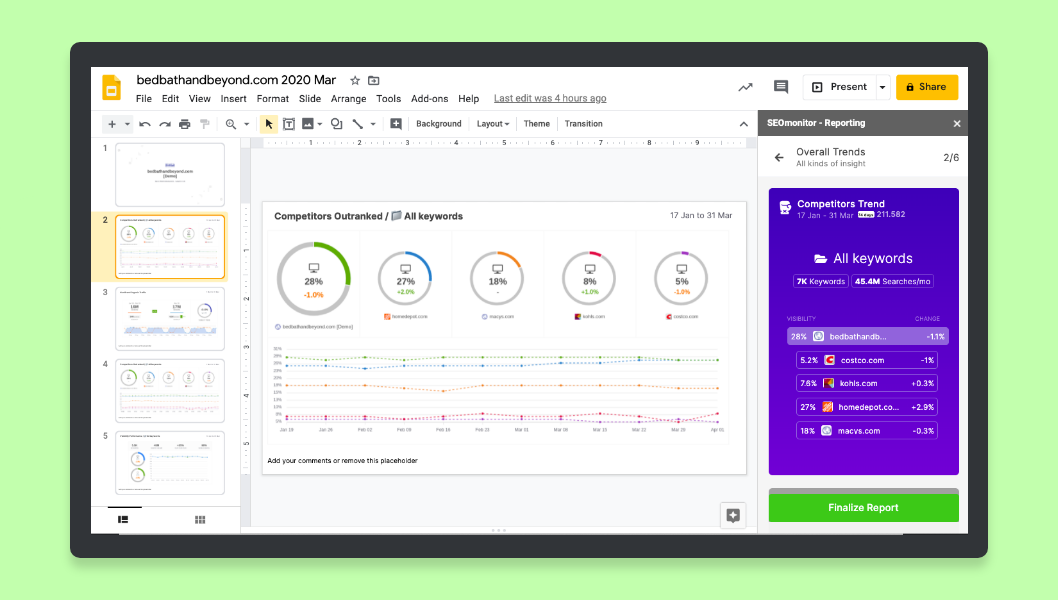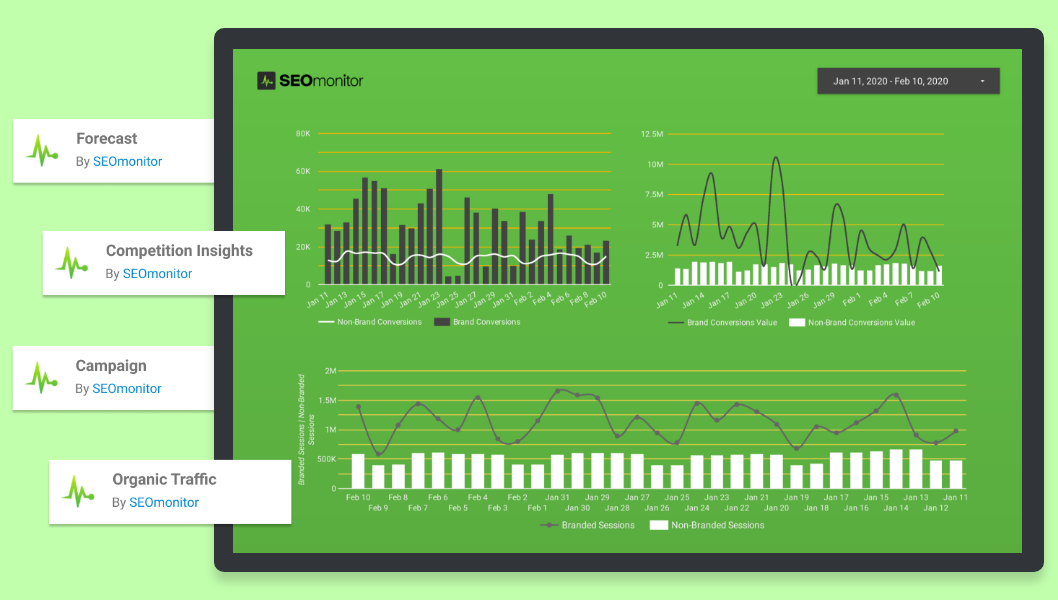What Does Success Look Like for Your Client?
First, you need to dive deep into your client’s expectations. Clarify their intent during the onboarding phase, and set the key metrics they need you to improve. It’s how they evaluate you, based on their marketing objectives, that helps you leave the other intermediary indicators aside:
- Is your client targeting a 50% growth in organic traffic in the following year? Then, you can focus on specific keyword groups, their visibility, and key ranking changes month over month.
- Is your client an ecommerce business focusing on conversions? You can think about reporting on organic-driven conversions and transactions as your key measure of success.
It doesn’t mean you won’t have the basics covered; it’s more about where to focus your client’s attention. By subtracting knowledge and reaching 1 to 3 KPIs that define success, you’ll already know what to highlight in your monthly reports.
“Don’t assume anything!” is what Reshma Vadgama, Head of Client Relationships at Liberty Marketing, pointed out when discussing how to manage expectations. Make sure you clarify everything when you gather new client data, create plans, report results, and manage client relationships overall.
In order to avoid any misunderstandings with clients, you need to double and triple-check everything, especially in the first few months of the relationship, Vadgama adds. In the beginning, success also means mapping out SEO activities so that clients know what each phase of your SEO campaign involves.
Keep It Simple, Not Simplistic
An SEO agency’s goal is to provide clients with a concise and actionable report. Following the subtraction logic, the key points need to be easy to understand and keep the client on track at all times.
Ask yourself:
- What is their primary purpose behind running the SEO campaign?
- What is their level of SEO understanding?
- How do you correlate success metrics to SEO actions?
Clients aren’t equally interested in all campaign results. Using the via negativa logic, now answer: What needs to stay out of the report to answer the above questions clear and on point?
For example, if you’re handling a web migration, your client won’t be interested in your long list of 404 errors. Still, a cannibalization issue on one of the high-intent keywords will spark interest and a list of fixes to urgently work on for their current landing pages.
Don’t Dismiss an Executive Summary
A report might have several slides or pages, but you also need an executive summary for clients who have only a minute to spare.
Highlight what is the current status of the agreed KPIs and SEO objectives, concentrating on:
- What specific KPIs did you accomplish? What needs more time?
- What trends did you notice? How do they impact the client’s objectives?
- How did the target (keyword) groups or content perform?
- Any SEO opportunities, issues to raise, or recommendations?
Think of it this way: CMOs will use your report in their brand review report to key stakeholders. You need to make it easy for them to attribute positive business performance to SEO efforts.
By reducing reports down to their most essential elements, you give CMOs a better chance of understanding your reports’ value when presenting them to stakeholders.
Make it easy for them to compare across months so clients see the long-term impact of SEO campaigns. You can do this by templating your KPI-focused reports, letting you consistently display key metrics and insights in the same format.
Explain All Visual Data Concisely
If clients can’t understand your report, they might dismiss it as irrelevant, and you consequently lose the opportunity to showcase results and receive quality feedback.
Take away anything that distracts – both in terms of the design and content of your visual data:
- Visual design should prioritize readability and understandability, leading the eye to crucial information. Use colors, font size, images, and other design aspects strategically to help clients absorb data better.
- Visual data should reflect or support what you most want to say. Visuals can do a great job setting the context or synthesizing multiple results into one big takeaway, but this doesn’t mean you should sneak in more data than actually necessary – this will just take focus away from critical objectives. Don’t forget to include explainers and one key takeaway per visual to keep it effective.
So, if there’s information that you can show instead of say, then do, but do it effectively.
Leverage Templates & Tools
You don’t want your team to spend hours churning out reports that could’ve been done faster with the right level of automation in custom digital tools. The elimination process here needs to take into account the tools’ capabilities to surface what’s crucial, be it:
- Visibility trends.
- Competitors outranked.
- New keyword opportunities.
- Cannibalization issues.
- Etc.
Using software that automates the data gathering process and plugs it into pre-designed templates is one way of streamlining the most time-consuming parts of the reporting process without relinquishing control over quality or design.
Another way is to leverage critical SEO campaign data into tools that help you be concise. For instance, you can think about what needs to be left out of your Data Studio template so you get your monthly key messages across.
Liberty Marketing conducted a reporting process audit with interviews to help them adapt and adjust to any client feedback. That’s how they discovered and filled gaps in their Data Studio custom reports, with clients asking for specific month over month or quarter over quarter views.
Knowing what to include and what to leave out, even with automation features in place, supports you in winning time for strategy, planned activities, and explaining which SEO interventions impacted business results – instead of gathering redundant data.
How Are You Using Your Reports to Generate Good Client Relationships?
While some clients don’t want to meet frequently, you still need to define multiple touchpoints based on their communication needs.
Reshma Vadgama says that the closer you are to clients, the more they’ll see your effectiveness. That’s because the more in touch you are with their strengths and weaknesses, the more effectively you can build reports – you’ll know what to say and how to say it for maximum impact to showcase how the project is doing.
“We take care of the ‘human element’ of our partnership with clients, making sure that we have a contribution to the growth in their company – and they see it.”
One of the ways the agency lives up to this promise is with its well-established reporting routine:
- Weekly emails or chats to keep the client close, share quick wins, or just take their pulse.
- Monthly reports, beginning with the first week of the month.
- Quarterly reviews to scale-up the SEO efforts, realign, start new projects, and so on.
- A 45-day call with each new client to reassess expectations and correct course, if necessary.
Plus, throughout their partnership, Vadgama’s team continuously interviews their clients to do quality-checks on the reports they send. This allows them to optimize for efficient communication.
The end goal here is not to overwhelm with too many communication channels or too much information, but to clearly define each touchpoint with its specific objective:
- A weekly chat won’t include major KPIs but can consist of a small SEO win.
- A monthly report won’t be about hanging out with your clients but driving the business forward.
- A quarterly report won’t focus on each technical SEO issue, but the “metanarrative” of the client’s SEO performance – what did we learn from the current quarter that needs to change in the next one?
Bonus: How Can a Reporting Manager Help?
Knowing how to build an efficient SEO agency report is one thing, but it’s another to monitor all the reports being made, sent, and viewed by clients on a portfolio level.
While everybody agrees that reports are crucial in keeping clients happy, reports are often overshadowed by more urgent tasks.
We at SEOmonitor recognized this and created a Reporting Manager that supports you with the critical data you need to manage the reporting process without getting overwhelmed. After all, a dashboard is only as good as the actionable insights you include in it, and the nudges it gives you to stay on track – subtracting knowledge is more important than ever here, as you don’t want a screen with all the data you can get.
That’s why our dashboard gives you:
- An overview of all agency reports and their status on a portfolio level: due, overdue, submitted, or in progress.
- A report builder that surfaces your key campaign data from SEOmonitor and helps you create a Google Slides presentation based on your chosen template. Our smart assistant automatically gathers and translates all relevant insights into slides and visual images in seconds.
- A client feedback tracker for each monthly report. This tells you which slides the client engaged with the longest and which they were most impressed or indifferent with.
This lets SEO agencies build an insight-packed report, ensure that clients read it, and monitor their reactions to your performance – everything needed for establishing positive, long-term client relations.
Conclusion
The via negativa method of building reports increases your agency’s efficiency and makes it easy for your clients to absorb and engage with complex SEO data.
Presenting only the most critical metrics to clients:
- Shows you’re aligned on a common definition of success.
- Makes clients more likely to actually read reports.
- Helps them better understand the value of SEO.
- Increases agency efficiency and frees up teams for other activities.
All of this drives client retention and fosters strong agency-client relations.
You can use SEOmonitor’s Reporting Manager to simplify report creation in this way, starting with what matters the most to the clients and “trimming the fat” to eliminate distraction.
Join us in our journey to build stronger client-agency partnerships!






